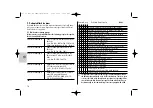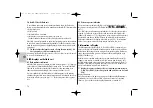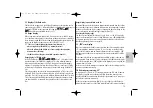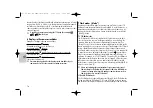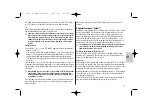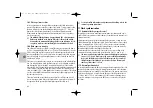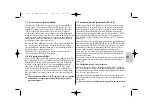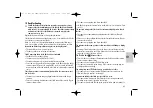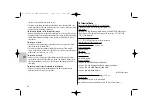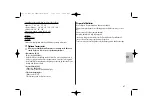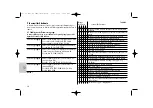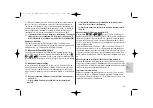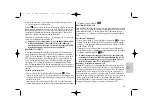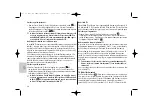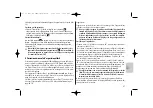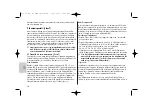
83
ķ
11.3 Second curtain synchronisation (REAR)
Some cameras offer the option of second-curtain synchronisation (REAR), in
which the flash unit is not triggered until the end of the exposure time. This is
particularly advantageous when used with lower shutter speeds (slower than
1/30 sec.) and moving subjects that have their own source of light. With
second-curtain synchronisation, a moving light source will trail a light streak
instead of building one up ahead itself, as it does when the flash is synchronised
with the first shutter curtain. In this way a „more natural“ image of the photo-
graphic situation is produced! Depending on its operating mode, the camera
sets shutter speeds slower than its sync speed.
On some cameras the REAR function is not possible in certain operating modes
(e.g., certain vari- or subject programs, or with red eye reduction). In these
cases, the REAR mode cannot be selected and/or is automatically cancelled or
ignored (see camera’s operating instructions).
The REAR mode is set on the camera (see camera’s operating instructions).
There is no display for REAR mode in the flash unit.
11.4 Slow synchronisation (SLOW)
A slow exposure (SLOW) gives added prominence to the image background at
lower ambient light levels. This is achieved by adjusting the shutter speed to the
ambient light. Accordingly, shutter speeds that are slower than the flash sync
speed (e.g., shutter speeds up to 30 sec.) are automatically adjusted by the
camera. Slow synchronisation is activated automatically on some camera
models in connection with certain camera programs (e.g., a night shot pro-
gram, etc.), or it can be set on the camera (see the camera’s operating instruc-
tions). No settings are necessary on the flash unit, nor is there any display for
this mode.
Slow synchronisation SLOW is set on the camera (see camera’s operating
instructions)! Use a tripod when shooting with slow shutter speeds to
avoid blurred images!
☞
11.5 Automatic high-speed synchronisation (FP or HSS)
Various cameras from Group E (D80, D2Hs and D200, for example) support
automatic FP high-speed synchronisation (see the camera’s operating instruc-
tions). This flash mode makes it possible to use a flash unit even with shutter
speeds that are faster than the flash sync speed. Interesting results may by
achieved in this mode when, for example, a wide open aperture (e.g., f/2.0) is
used to limit the depth of field in portrait shots taken in very bright ambient
light. The flash unit supports high-speed synchronisation in i-TTL, i-TTL and M
flash modes.
For physical reasons, however, high-speed synchronisation significantly reduces
the number and the maximum flash range. Be sure to note, therefore, the flash
range on the display of the flash unit. High-speed synchronisation is activated
automatically if a shutter speed faster than the flash sync speed is set on the
camera, whether manually or automatically by the exposure program.
? Note that in the case of high speed synchronisation the guide number of the
flash unit also depends on the shutter speed. The faster the shutter speed, the
lower the guide number!
The setting for automatic high-speed synchronisation occurs on the camera (see
camera operating instructions)! The display of the flash unit then in addition
shows „HSS“.
11.6 Preflash function for red-eye reduction
The red-eye effect occurs when the person being photographed is looking for
more or less straight into the camera, the ambient lighting is poor, and the flash
unit is mounted close to the camera. The flash unit then illuminates the interior of
the subject’s eyes through the pupils.
Some camera models have a preflash function for reducing the red-eye effect.
One or more preflashes induce the pupils to contract more, thereby reducing the
red-eye effect.
On some cameras, the preflash function supports only the camera’s inter-
☞
707 47 0081.A2 48AF-1Nikon/Inh. 19.09.2007 12:42 Uhr Seite 83


